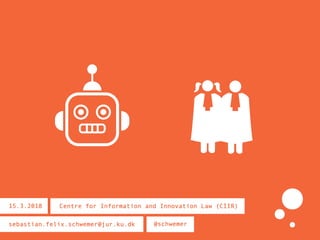
Introduction to artificial intelligence and law
- 1. Centre for Information and Innovation Law (CIIR)15.3.2018 sebastian.felix.schwemer@jur.ku.dk @schwemer
- 3. Status quo AI and lawyers AI and law / regulation 45 min Questions
- 4. Status quo
- 5. What is artificial intelligence?
- 6. [The process] of making a machine behave in ways that would be called intelligent if a human were so behaving. John McCarthy, 1955
- 7. Problematic to use human capabilities as benchmark for AI…
- 8. Actuated mechanism programmable in two or more axes (4.3) with a degree of autonomy (2.2), moving within its environment, to perform intended tasks ISO 8373:2012(en), Robotics and robotic devices
- 9. Hollywood og journalister (samt nogle professorer) har en tendens til at tale meget mere om dette "mystiske" med 'neurale netværk' og 'kunstig intelligens' og lignende i stedet for at sige det, som det er: Der er tale om avancerede algoritmer og statiske beregningsmetoder. Stephen Alstrup, Københavns Universitet, Professor at Datalogisk Institut (2017)
- 10. Buzzword bingo: Big data, (Applied) Machine Learning, Deep Learning, Data Science, Neural Networks, Pattern Recognition, Algorithms… ¯_(ツ)_/¯
- 11. 1949 Claude Shannon Minimax 1997 Deep Blue ./. Gary Kasparov 2011 IBM Watson Jeapordy 2016 AlphaGo ./. Lee Sedol 2017 AlphaGo ./. Ke Jie
- 13. Slide 13
- 14. Learning Language Vision Speech
- 16. Slide 16
- 18. Slide 18
- 19. Slide 19
- 20. Slide 20
- 21. Slide 21
- 22. Slide 22
- 23. Slide 23
- 24. Medical Finance Logistics Agriculture Transport Retail
- 25. Why AI and law now?
- 29. Expectations Peak of inflated expectations Plateau of productivity Slope of enlightenment Trough of disillusionment
- 31. A smart contract is a set of promises Specified in digital form Including protocols based on which Contracting parties perform on these promises Nick Szabo
- 32. The term smart contract can be so confusing. Really it is just a self-executing piece of code on a distributed ledger. Primavera de Felippi, National Centre of Scientifc Research, Paris
- 33. Increased computing capacity Cheaper data storage Accessible technology stack
- 34. Slide 34
- 36. Slide 36
- 37. AI and law
- 39. Regulating AI
- 40. Slide 40
- 41. Slide 41
- 43. Slide 43
- 44. Should we regulate AI? Can we regulate AI?
- 45. Slide 45
- 46. Other implications for society?
- 48. Slide 48
- 49. 1) Research Goal: The goal of AI research should be to create not undirected intelligence, but beneficial intelligence. 8) Judicial Transparency: Any involvement by an autonomous system in judicial decision-making should provide a satisfactory explanation auditable by a competent human authority. 11) Human Values: AI systems should be designed and operated so as to be compatible with ideals of human dignity, rights, freedoms, and cultural diversity.
- 50. 1) A robot may not injure a human being or, through inaction, allow a human being to come to harm; 2) A robot must obey the orders given it by human beings except where such orders would conflict with the First Law; 3) A robot must protect its own existence as long as such protection does not conflict with the First or Second Laws A robot may not harm humanity, or, by inaction, allow humanity to come to harm Three Laws of Robotics, Isaac Asimov (1950)
- 52. Copyright…
- 53. Slide 53
- 54. Slide 54
- 56. or privacy...
- 57. ”The data subject should have the right not to be subject to a decision, which may include a measure, evaluating personal aspects relating to him or her which is based solely on automated processing and which produces legal effects concerning him or her or similarly significantly affects him or her, such as automatic refusal of an online credit application or e-recruiting practices without any human intervention.” GDPR, recital 71, Section 4 Right to object and automated decision making (Art. 22)
- 58. And liability...
- 60. Slide 60
- 62. creating a specific legal status for robots in the long run, so that at least the most sophisticated autonomous robots could be established as having the status of electronic persons responsible for making good any damage they may cause, and possibly applying electronic personality to cases where robots make autonomous decisions or otherwise interact with third parties independently; Point 59 lit. f
- 63. Slide 63
- 64. Slide 64
- 65. Slide 65
- 66. AI and lawyers
- 67. 1754 f.Kr. Code of Hammurabi #LegalTech
- 69. People with a law degree People who code
- 70. People with a law degree People who code
- 72. Hypotesis: the ability to analyse big data will become essential in the legal profession
- 75. Productivity
- 76. Of junior lawyer work will be done by technology * 2016 Boston Consulting Group & Bucerius Law School report 30-50%
- 77. Less time by use of existing automation technology * 2016 Dana Remus & Frank S. Levy, Can Robots Be Lawyers? Computers, Lawyers, and the Practice of Law 13%
- 81. Prediction
- 82. Slide 82
- 83. Slide 83
- 84. Slide 84
- 85. Slide 85
- 90. Slide 90
- 91. Slide 91
- 94. Centre for Information and Innovation Law (CIIR) sebastian.felix.schwemer@jur.ku.dk Conclusions @schwemer
- 95. Credits Creative commons attribution Hieroglyphic by Luke Anthony Firth (Noun Project) Chain by ruliani (Noun Project) Laptop by B. Agustín Amenábar Larraín (Noun Project) Robot by Maxim Kulikov (Noun Project) Pawn by Vallone Design (Noun Project) Stopwatch by Veronika Krpciarova (Noun Project) Lawyer by Miroslav Kurdov (Noun Project) Lawyer 2 by Miroslav Kurdov (Noun Project) Denmark by Chameleon Design (Noun Project) Bitcoin by Adrien Coquet (Noun Project) Another game of Go by Chad Miller (Flickr) Vietnam War 1964 by manhhai (Flickr)
